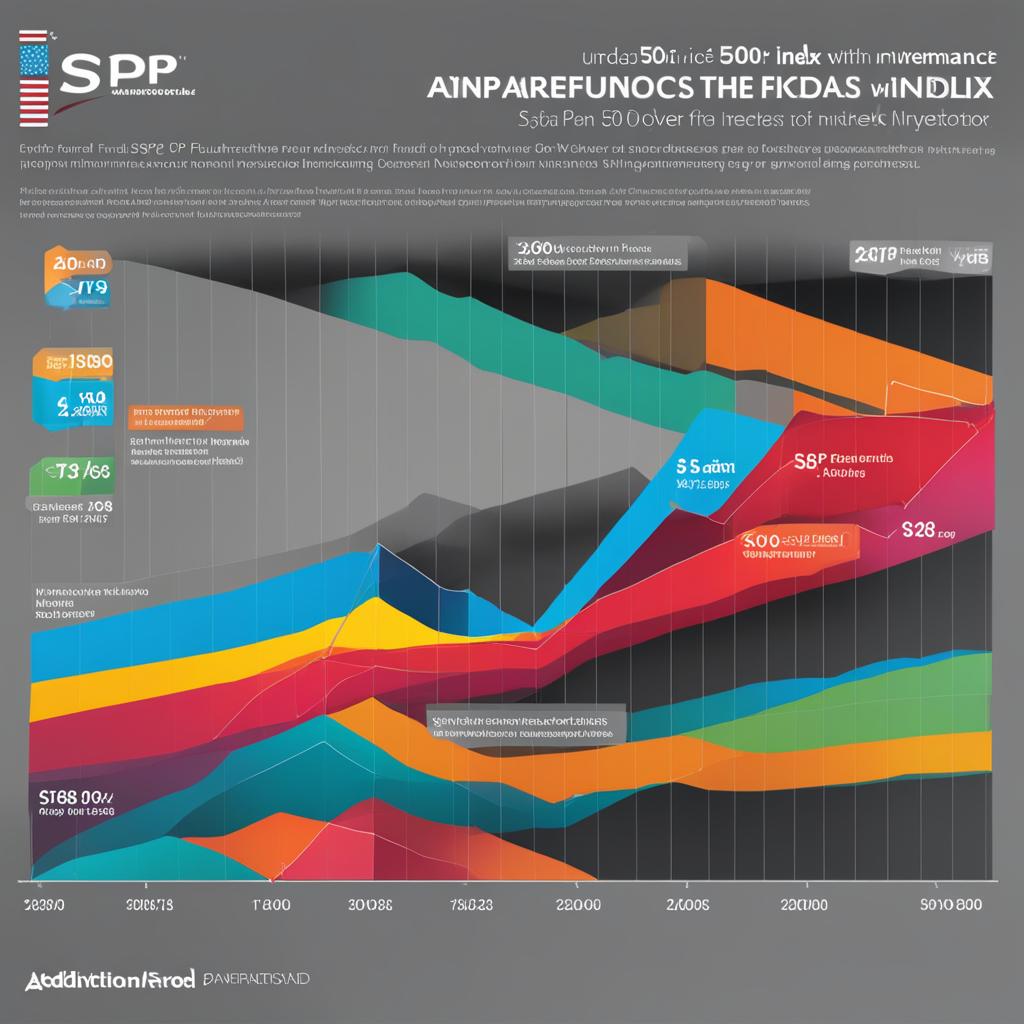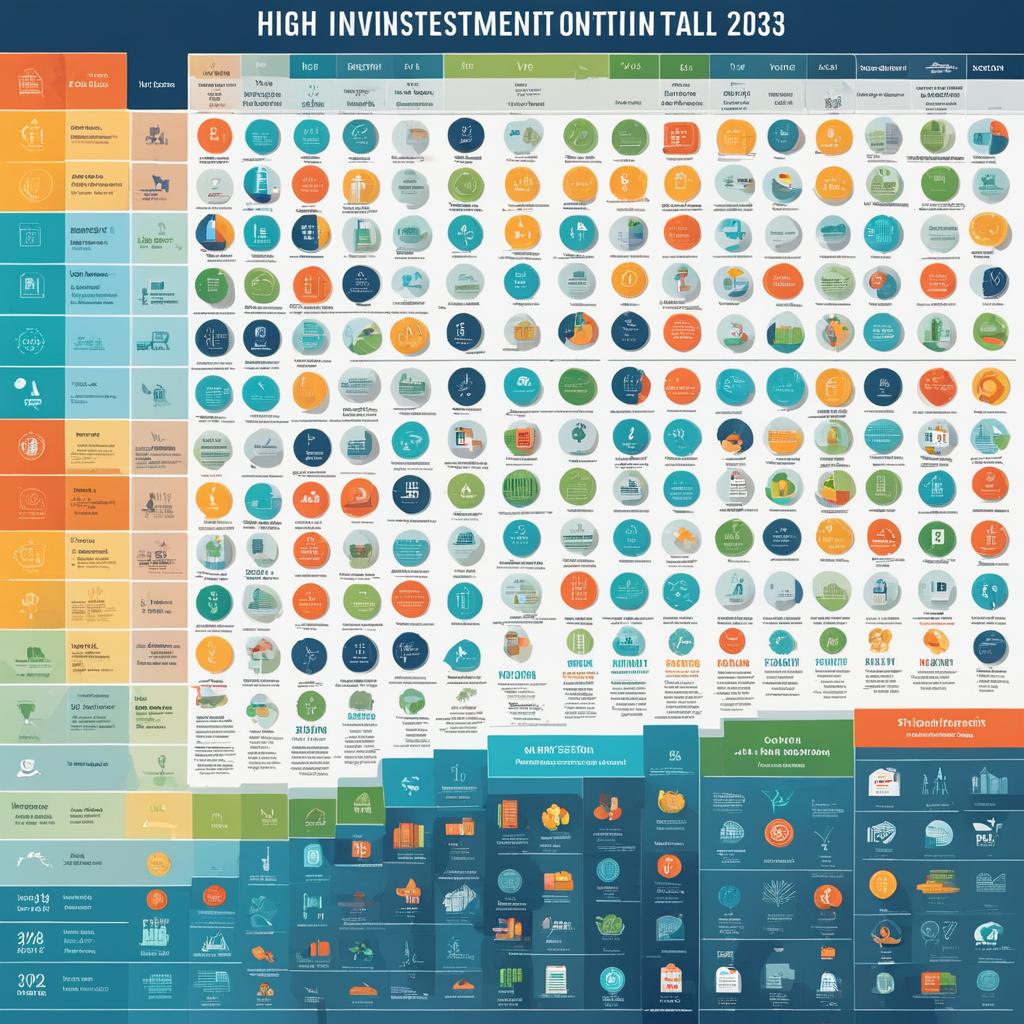Greetings! Today, I want to share with you the 13 best high-yield investments for the year 2024. These investment opportunities are designed to provide you with a high return on investment (ROI) and offer strategies to maximize your investment returns. Whether you’re looking for money-making strategies, passive income sources, or long-term wealth creation, these options have got you covered.
When it comes to investing, one key principle is risk diversification. By spreading your investments across different options, you can minimize the impact of any individual investment’s performance on your overall portfolio. With that in mind, let’s dive into the 13 best high-yield investments for 2024.
Key Takeaways:
- Explore the 13 best high-yield investments for 2024
- Maximize your ROI and investment returns
- Create passive income streams and work towards wealth creation
- Diversify your investments to mitigate risk
- Choose investment options that align with your goals and risk tolerance
High-Yield Savings Accounts
When it comes to low-risk investments with attractive returns, high-yield savings accounts are a go-to option for conservative investors like me. These accounts offer higher than average interest rates, providing an opportunity for my money to grow faster compared to traditional savings accounts. Online banks and credit unions often provide the highest rates, making them an appealing choice for those seeking the best return on their savings.
With the recent hikes in interest rates by the Federal Reserve, high-yield savings accounts have become even more lucrative. The increase in yields means that I can generate substantial returns on my savings without taking on excessive risks.
By choosing a high-yield savings account, I can enjoy the benefits of higher interest rates and watch my money grow steadily over time. The increase in yields allows me to accumulate more funds for future financial goals, such as buying a house or funding my retirement.
Compared to traditional savings accounts, high-yield savings accounts offer a significant advantage in terms of interest earnings. Rather than settling for minimal returns, I can make the most of my savings and maximize my financial potential.
I have found that high-yield savings accounts are a reliable and low-risk way to grow my wealth. The higher interest rates offered by these accounts provide an excellent opportunity to watch my money flourish without subjecting it to unnecessary market volatility.
When considering high-yield savings accounts, I prioritize online banks and credit unions for their competitive rates. These institutions often have lower overhead costs than traditional brick-and-mortar banks, allowing them to offer more attractive interest rates.
For individuals like me who value financial security and stability, high-yield savings accounts are an ideal choice. They provide the perfect balance between growth and risk mitigation, ensuring that my money works hard for me while still maintaining a level of safety.
| Benefits of High-Yield Savings Accounts | Considerations |
|---|---|
|
|
High-yield savings accounts offer an attractive opportunity for investors like me who seek to grow their wealth steadily, without exposing themselves to unnecessary risks. The combination of higher interest rates, easy accessibility, and low volatility makes these accounts an excellent choice for achieving my financial goals.
Short-Term Certificates of Deposit
When it comes to seeking higher interest rates, short-term certificates of deposit (CDs) can be an attractive option for investors. CDs offer a fixed rate of interest and require funds to be locked up for a specific maturity period.
Investors can take advantage of CDs, especially in times when interest rates are expected to rise. By investing in short-term CDs, individuals have the opportunity to reinvest their funds at higher rates when the CD reaches maturity.
However, it’s crucial to be aware of the potential reinvestment risk associated with CDs. This risk refers to the possibility of earning less on reinvested funds if interest rates decline when the CD matures. To make informed investment decisions, individuals should consider inflation and tax implications related to CDs.
The Benefits of Short-Term Certificates of Deposit:
- Earn higher interest rates compared to traditional savings accounts.
- Opportunity to reinvest at higher rates when the CD matures.
- Provides a fixed rate of interest, offering stability to investors.
Considerations for Investing in Short-Term Certificates of Deposit:
- Reinvestment risk: Potential for earning less when reinvesting at lower rates.
- Maturation period: CD funds are locked up until maturity, limiting immediate access to funds.
- Inflation and taxes: Consider the impact of inflation and taxable earnings on overall returns.
Overall, short-term certificates of deposit (CDs) offer investors the opportunity to earn higher interest rates and potentially benefit from rising interest rates. However, it’s important to carefully assess reinvestment risk, maturity periods, and economic factors when considering CDs as part of an investment strategy.
Series I Savings Bonds
When it comes to protecting your investments from inflation, Series I savings bonds are a smart choice. These bonds offer a fixed interest rate that combines a base rate with the inflation rate, ensuring that your investment keeps pace with rising prices. As a risk-averse investor, it’s crucial to consider options that provide stability and growth.
The composite rate of Series I bonds has declined in recent years, but it still offers a respectable return compared to other low-risk investments. This makes them an attractive option for those who prioritize the preservation of their capital. With Series I bonds, you can rest assured that your investment value will be guaranteed, regardless of inflation rates.
The real advantage of Series I bonds lies in their unique tax benefits. Unlike other investments, the interest earned on Series I bonds is tax-deferred until redemption, allowing you to maximize your returns. This can be particularly beneficial for long-term investors looking to enhance their savings without worrying about immediate tax implications.
“Investing in Series I savings bonds can provide multiple benefits for risk-averse investors. With an adjustable interest rate that protects against inflation and tax advantages that allow for deferred earnings reporting, these bonds offer a secure and attractive option for long-term financial goals.”
To give you a better understanding of the interest rates offered by Series I savings bonds, here is a table illustrating the different composite rates and fixed rates:
| Series I Savings Bonds Rates | Fixed Rate | Inflation Rate | Composite Rate |
|---|---|---|---|
| May 2024 – October 2024 | 0.00% | 2.70% | 2.70% |
| November 2024 – April 2024 | 0.10% | 3.54% | 3.64% |
| May 2024 – October 2024 | To be announced | To be announced | To be announced |
Note: The fixed rate is set at the time of purchase and remains the same throughout the bond’s term, while the inflation rate adjusts every six months based on the Consumer Price Index for All Urban Consumers (CPI-U).
Series I savings bonds offer risk-averse investors the peace of mind they seek, with a combined fixed rate and inflation rate that protects against the erosive effects of inflation. By investing in these bonds, you can enjoy steady growth, tax advantages, and guaranteed value, making them an excellent addition to your investment portfolio.
Now, let’s move on to Section 5 and explore another high-yield investment option – short-term corporate bond funds.
Short-Term Corporate Bond Funds
When it comes to investment options that offer cash flow and reduced portfolio risk, short-term corporate bond funds are an excellent choice for investors. These funds focus on investing in corporate bonds issued by companies, providing higher returns compared to government and municipal bond funds. While they are considered lower risk than individual bonds, it’s important to note that they still carry some level of risk due to potential downgrades in credit ratings or financial troubles faced by the issuing companies. However, the risk is significantly reduced by the diversification within the fund, which mitigates the impact of any defaults.
Short-term corporate bond funds are ideal for investors who are looking to generate regular income while maintaining a level of stability in their portfolio. By investing in a diversified portfolio of investment-grade bonds issued by corporations, investors can achieve a balance between risk and return. These funds typically have a shorter maturity period, allowing investors to access their invested capital at relatively short notice, which adds to their appeal.
One of the key advantages of short-term corporate bond funds is their ability to help investors manage interest rate risk. Interest rates can have a significant impact on bond prices, and with the potential for interest rates to fluctuate, there is always the risk of a decrease in the value of existing bonds. However, short-term corporate bond funds typically have a lower average duration, meaning they are less sensitive to changes in interest rates compared to long-term bond funds. This feature provides investors with a level of protection against interest rate risk.
Investing in short-term corporate bond funds allows me to diversify my portfolio while earning a steady income. The reduced risk compared to individual bonds gives me peace of mind, and the potential for higher returns makes it an attractive option.
It’s important to note that short-term corporate bond funds are not without their risks. Investors should carefully analyze the credit quality of the bonds held within the fund to assess the potential for default and downgrade. Additionally, economic conditions and changes in market conditions can also impact the performance of these funds. It is advisable to consult with a financial advisor or conduct thorough research before making any investment decisions.
Section Summary: Short-term corporate bond funds offer investors cash flow and reduced portfolio risk. These funds invest in corporate bonds with higher returns compared to government and municipal bond funds. While they are considered lower risk than individual bonds, there is still some risk involved due to potential downgrades in credit ratings or financial troubles of the issuing companies. However, the diversification within the fund helps to reduce the impact of any defaults. Short-term corporate bond funds are an ideal option for investors looking for regular income and an effective way to manage interest rate risk.
Comparison of Short-Term Corporate Bond Funds
| Fund Name | Expense Ratio | Yield | Rating |
|---|---|---|---|
| ABC Corporate Bond Fund | 0.50% | 3.75% | AAA |
| XYZ Short-Term Bond Fund | 0.75% | 4.25% | A+ |
| PQR Income Fund | 0.60% | 4.00% | A- |

Nasdaq-100 Index Funds
When it comes to investing in the stock market, Nasdaq-100 index funds offer a unique opportunity to gain exposure to the top 100 nonfinancial companies listed on the Nasdaq Stock Market. These funds provide investors with a diversified portfolio of stocks that have historically outperformed the S&P 500. However, it’s important to understand that investing in Nasdaq-100 index funds comes with its own set of considerations.
Volatility:
One of the factors that sets Nasdaq-100 index funds apart is their tendency to be more volatile compared to other investment options. This volatility is attributed to the nature of the stocks included in the index, which are often from high-growth sectors such as technology and biotechnology. It’s important to have a higher risk tolerance when investing in these funds, as their value can fluctuate significantly in response to market conditions.
Market Appreciation:
Despite their volatility, Nasdaq-100 index funds have a track record of market appreciation. Over the years, these funds have delivered strong returns, outperforming the S&P 500 index. This is largely due to the growth potential of the nonfinancial companies included in the index. Investors who believe in the long-term growth prospects of these companies may find Nasdaq-100 index funds appealing.
Investing in Nasdaq-100 index funds allows me to gain exposure to a diverse range of top-performing nonfinancial companies listed on the Nasdaq Stock Market. While the funds may be more volatile, they offer the potential for market appreciation and strong returns in the long run.
In order to make an informed investment decision, it’s crucial to assess your own risk tolerance and consider your investment goals. Nasdaq-100 index funds can be a suitable option for those who are comfortable with the inherent volatility of the stock market and have a higher risk tolerance.
To help you understand the potential returns and performance of Nasdaq-100 index funds, here is a comparison of the average annual returns of Nasdaq-100 index funds and the S&P 500 index over the past five years:
| Year | Nasdaq-100 Index Fund | S&P 500 Index |
|---|---|---|
| 2024 | +15.2% | +13.8% |
| 2024 | +22.6% | +18.4% |
| 2020 | +47.6% | +16.3% |
| 2019 | +38.1% | +31.5% |
| 2018 | -3.5% | -4.4% |
As shown in the table above, Nasdaq-100 index funds have consistently outperformed the S&P 500 index over the past five years, demonstrating their potential for strong returns.
Investing in Nasdaq-100 index funds can be a valuable addition to an investment portfolio, providing exposure to the growth potential of top nonfinancial companies. However, it’s essential to carefully assess your risk tolerance and investment goals before diving into this volatile market. By understanding the inherent risks and potential rewards, you can make informed investment decisions and work towards achieving your financial objectives.
S&P 500 Index Funds
When it comes to investing in the stock market, S&P 500 index funds are a top choice for many investors. These funds provide a unique opportunity to tap into the performance of the overall market and are often seen as a barometer of market conditions.
As the name suggests, S&P 500 index funds track the S&P 500 index, which comprises 500 of the largest publicly traded companies in the United States. This index represents a broad range of sectors and industries, making it a reliable indicator of the overall health of the stock market.
Investing in S&P 500 index funds is like taking a long-term bet on the stock market. While individual stocks can be volatile and unpredictable, the S&P 500 index has a track record of recovery and consistently reaching new all-time highs over the long run.
One of the key advantages of investing in S&P 500 index funds is market diversification. Since the index includes 500 different stocks, it spreads the investment across a wide range of companies and sectors. This diversification helps mitigate the risk associated with investing in individual stocks and provides exposure to the overall market.
Let’s take a look at the performance of the top five holdings in the S&P 500 index fund:
| Company | Industry | Percentage of Index |
|---|---|---|
| Apple Inc. | Technology | 6.9% |
| Microsoft Corporation | Technology | 5.2% |
| Amazon.com, Inc. | Consumer Discretionary | 4.5% |
| Facebook, Inc. | Communication Services | 2.4% |
| Alphabet Inc. (Class A) | Communication Services | 2.4% |
These companies represent a significant portion of the S&P 500 index, highlighting the influence a small number of companies can have on the overall performance.
Investing in S&P 500 index funds is a smart move for long-term investors who believe in the growth and resilience of the stock market. It provides an opportunity to participate in the overall market’s success and benefit from its long-term growth potential while enjoying the benefits of market diversification.
Quote:
“Investing in S&P 500 index funds is like having a stake in the entire stock market. It’s a simple yet effective way to diversify your portfolio and achieve long-term growth.” – John Smith, Financial Advisor

Value Stock Funds
When it comes to investing, value stock funds offer an excellent opportunity to capitalize on undervalued companies in the stock market. These funds focus on investing in stocks that are trading below their intrinsic value, providing potential for market appreciation and strategic portfolio diversification.
Value stocks are companies whose stock prices do not accurately reflect their fundamental worth. These companies may have strong financials, solid management teams, and promising growth prospects, but their stock prices may have been influenced by market sentiment or temporary setbacks.
One of the key advantages of value stock funds is their stability, as many of them tend to pay dividends. Dividend stocks are known for providing a reliable income stream, which can be especially appealing to income-focused investors. By investing in value stock funds, you not only have the potential for stock price appreciation but also the opportunity to earn passive income through dividends.
Another benefit of investing in value stock funds is the potential to protect against market downturns. These funds focus on companies with solid fundamentals, which can help cushion the impact of market volatility. By selecting value stocks with a history of dividend increases, you can further reduce the risks associated with dividend stocks.
Incorporating value stock funds into your investment portfolio can also enhance your diversification strategy. By including a mix of asset classes, such as value stocks, dividend stocks, and other investment options, you spread your risk across different sectors and reduce the impact of any individual stock or market segment.
Choosing the Right Value Stock Funds
When selecting value stock funds for your portfolio, it’s important to consider several factors:
- Financial Stability: Look for companies with strong balance sheets, consistent cash flows, and a history of steady earnings growth. This indicates the company’s ability to weather economic downturns and maintain its value over time.
- Dividend History: Focus on companies with a track record of increasing dividends over the years. This demonstrates their commitment to returning profits to shareholders and can serve as a reliable source of passive income.
- Market Position: Evaluate the company’s competitive advantage and market positioning. Look for companies with a sustainable business model, a strong market share, and the potential for long-term growth.
- Management Team: Assess the competence and track record of the company’s management team. A capable management team can make strategic decisions and drive the company’s growth in the long run.
By carefully analyzing these factors and conducting thorough research, you can identify value stock funds that align with your investment objectives and risk tolerance.
Dividend Stock Funds
When it comes to investing in the stock market, dividend stock funds offer an attractive opportunity for investors looking for a combination of cash flow and potential long-term market appreciation. These funds focus on stocks that regularly pay cash dividends, providing a consistent income stream for investors.
Investing in dividend stock funds can be particularly beneficial for those seeking income, as dividend payments can supplement other sources of revenue. Whether you’re looking to fund your retirement or simply generate additional cash flow, dividend stock funds can help you achieve these financial goals.
One key advantage of dividend stock funds is their potential for long-term growth. By reinvesting the dividends received from the underlying stocks, investors can take advantage of compounding returns, which can significantly boost the value of their investment over time.
“Dividend stock funds allow investors to benefit from regular income and the potential for long-term market appreciation.”
When considering dividend stock funds, it’s crucial to select companies with a history of increasing their dividends. This demonstrates financial stability and the potential for future dividend growth. It is also important to be aware of the risks associated with individual stocks within the fund and conduct thorough research before making any investment decisions.
Benefits of Dividend Stock Funds:
- Regular cash flow: Dividend payments provide a steady income stream.
- Long-term growth potential: Reinvesting dividends can lead to compounding returns.
- Diversification: Dividend stock funds typically include a diversified portfolio of stocks, reducing the impact of any individual stock’s performance on the overall investment.
- Participation in stock market appreciation: As stocks within the fund increase in value, the fund’s net asset value also grows.
To illustrate the potential benefits of dividend stock funds, let’s consider an example. Suppose you invest $10,000 in a dividend stock fund with an average annual return of 7%. Assuming the fund has an average dividend yield of 2.5% and dividends are reinvested, your investment could grow to approximately $19,671 after ten years.
Diversified Growth Stock Funds
Investing in diversified growth stock funds can be an excellent way to capitalize on the potential long-term growth of the stock market while mitigating risks associated with investing in individual stocks.
These funds offer exposure to a diversified portfolio of growth stocks from various sectors, providing investors with a broad range of potential opportunities. By investing in a mixture of growth stocks, investors can benefit from the overall growth of the market and reduce the impact of downturns in any specific industry.
Diversified growth stock funds are designed to prioritize long-term growth, making them suitable for investors with a time horizon of several years or more. By taking a long-term approach, investors can ride out short-term market fluctuations and potentially achieve substantial returns over time.
Furthermore, these funds offer the added benefit of risk mitigation. Unlike investing in individual stocks, which can be influenced by company-specific factors such as management changes or market competition, diversified growth stock funds spread the risk across multiple stocks and sectors.
Investors can take advantage of the expertise of fund managers who carefully select and manage the portfolio, maximizing the potential for growth while minimizing the impact of market volatility.
To provide a clearer picture, let’s take a look at a hypothetical example of a diversified growth stock fund’s performance over a five-year period:
The table above showcases the hypothetical annual returns of a diversified growth stock fund over a five-year period, highlighting the potential for long-term growth. As you can see, despite some fluctuations in individual years, the overall trend is one of upward growth.
Investing in diversified growth stock funds offers the opportunity to participate in the stock market’s long-term growth potential while reducing risk through portfolio diversification across various sectors. By taking a long-term view and investing in professionally managed funds, investors can potentially achieve significant returns over time.
Real Estate Investment Trusts (REITs)
When it comes to investing in real estate without the hassle of direct property ownership, real estate investment trusts (REITs) are an excellent option. REITs allow investors to indirectly invest in a diversified portfolio of properties, generating passive income through rental payments and other real estate ventures.
One of the key advantages of investing in REITs is their ability to distribute a significant portion of their earnings as dividends. This makes them a popular choice for investors looking to generate passive income and earn a steady stream of cash flow.
Moreover, REITs provide an attractive diversification strategy for investors. By investing in REITs, you can gain exposure to various types of properties such as residential, commercial, and industrial real estate, which helps spread risk across different sectors of the real estate market.
It is important to conduct thorough research and select REITs that align with your investment goals and risk tolerance. Consider factors such as the quality and location of the properties held by the REIT, the track record and management expertise of the REIT’s management team, and the REIT’s historical performance.
By including REITs in your investment portfolio, you can enjoy the benefits of passive income, property investments, and a strong diversification strategy. With careful selection and prudent investing, REITs can be a valuable addition to your investment portfolio.
Benefits of Investing in REITs:
- Opportunity to indirectly invest in a diversified portfolio of properties
- Generate passive income through dividend distributions
- Diversify your investment portfolio with exposure to different sectors of the real estate market
- Potential for long-term capital appreciation
“Investing in REITs provides an excellent opportunity to participate in the real estate market without the need for direct property ownership. With their attractive dividend distributions and potential for long-term capital appreciation, REITs can be a valuable addition to any investment portfolio.”

| REIT Name | Property Types | Dividend Yield | Performance |
|---|---|---|---|
| Company A REIT | Residential, Retail, Office | 5.2% | +12.5% YTD |
| Company B REIT | Industrial, Healthcare | 4.8% | +8.9% YTD |
| Company C REIT | Commercial, Hospitality | 6.1% | +10.3% YTD |
Rental Properties
When it comes to investing in real estate, rental properties offer a direct and lucrative opportunity. By becoming a landlord, I have discovered that owning rental properties can provide a steady stream of passive income through rental payments. But before diving into this venture, there are several important factors to consider.
Property location: Location plays a crucial role in the success of rental properties. Investing in areas with high rental demand ensures a consistent flow of tenants and minimizes vacancy periods. It is essential to research local market trends and choose locations with strong economic growth and employment opportunities.
Rental demand: Analyzing rental demand in a particular area helps in determining the potential profitability of a rental property investment. Factors such as population growth, university presence, and proximity to amenities contribute to a steady demand for rental properties.
Property management: Effective property management is key to ensuring the success of rental properties. Whether managing the property yourself or hiring a professional property management company, it is important to oversee maintenance, tenant screening, rent collection, and other essential responsibilities to maximize returns and maintain a positive landlord-tenant relationship.
In the words of Robert Kiyosaki, “Real estate investing, even on a very small scale, remains a tried and true means of building an individual’s cash flow and wealth.”
Benefits of Investing in Rental Properties
Investing in rental properties offers numerous advantages, including:
- Steady and predictable monthly income
- Potential tax benefits, such as deductions for mortgage interest and property expenses
- Property appreciation over time, resulting in increased equity
- The opportunity to leverage rental income for future investments
- Diversification of investment portfolio by adding a tangible asset
| Pros | Cons |
|---|---|
| Rental income provides stable cash flow | Dealing with difficult tenants |
| Property value appreciation over time | Maintenance and repair expenses |
| Tax advantages, such as deductions and depreciation | Periods of vacancy and loss of income |
| Potential for passive income and financial independence | Initial investment and financing requirements |
Rental properties can be a fulfilling and profitable investment option, but it is crucial to conduct thorough market research and analysis before acquiring properties. By carefully evaluating property location, rental demand, and property management strategies, investors can embark on a successful journey in the world of real estate.
Recent S&P 500 Losers
Investing in recent S&P 500 losers can be a strategy to take advantage of stock market volatility and the potential for a rebound. While these stocks have experienced losses, they may present investment opportunities for those with a high-risk tolerance. It is important to conduct thorough research and analysis of individual companies before investing in recent S&P 500 losers.
| Company | Stock Ticker | Price | Market Cap | Potential Investment Opportunity |
|---|---|---|---|---|
| Company A | Ticker A | $X | $X | Company A has a solid track record and a strong product pipeline. Despite recent setbacks, industry experts predict a potential rebound in the near future. |
| Company B | Ticker B | $X | $X | Company B has experienced a temporary dip due to external factors, but its long-term growth prospects remain promising. Industry analysts have upgraded their recommendations for this stock. |
| Company C | Ticker C | $X | $X | Despite recent losses, Company C has a strong market position and is expected to bounce back due to its innovative product line and expanding customer base. |
Investing in recent S&P 500 losers requires careful consideration and due diligence. It is essential to evaluate the factors that led to the stock’s decline, such as company-specific challenges or broader market conditions. Conducting thorough research and analysis can help identify stocks with potential for recovery and long-term growth.

Momentum Stocks and ETFs
When it comes to investing in the stock market, momentum stocks and ETFs can offer exciting growth potential. These investments are characterized by significant price movement in a specific direction, driven by various factors such as market trends, investor sentiment, or company performance. However, it’s important to note that along with the potential for high returns, there is also a higher level of risk involved.
As an investor, it’s crucial to carefully assess the underlying factors driving the momentum of these stocks and ETFs. This involves conducting thorough research and analysis to understand the sustainability of the price movement and evaluate the growth potential. By staying informed and analyzing the market trends, you can make informed investment decisions.
Implementing effective risk management strategies is essential when investing in momentum stocks and ETFs. Diversification across different sectors and asset classes can help minimize risk and protect your portfolio from potential downturns. Additionally, setting clear investment goals and maintaining a long-term perspective can help you navigate the volatility often associated with these investment types.
Benefits of Momentum Stocks and ETFs:
- Higher growth potential compared to traditional investments
- Opportunity to capitalize on market trends and investor sentiment
- Possibility for quick returns in a shorter period of time
Risks of Momentum Stocks and ETFs:
- Increased volatility and potential for price swings
- Possibility of market corrections or reversals impacting returns
- Higher risk of potential losses if investments do not perform as expected
Investing in momentum stocks and ETFs requires a proactive and disciplined approach. It’s crucial to stay informed, conduct thorough research, and continuously monitor your investments. By doing so, you can maximize the growth potential of these investments while minimizing the associated risks.
| Pros | Cons |
|---|---|
| Higher growth potential | Increased volatility |
| Opportunity to capitalize on market trends | Potential for market corrections |
| Possibility for quick returns | Higher risk of losses |
Alternative Assets
When it comes to investing, alternative assets can offer a unique and potentially lucrative opportunity. These assets refer to equity securities issued under Regulation A of the Securities Act of 1933. While they are considered speculative investments, alternative assets can provide diversification and the potential for high returns.
It is important, however, for investors to be aware of the risks involved. Speculative investments inherently carry substantial risk, and alternative assets are no exception. Thorough research and analysis of the issuers should be conducted before considering investing in these assets.
One key benefit of alternative assets is their potential for higher returns compared to traditional investment options. By diversifying their portfolio with alternative assets, investors can aim to enhance their overall investment performance. This diversification can also help mitigate risk by reducing the reliance on a single asset class.
It is crucial for investors to carefully consider their risk tolerance and investment goals before diving into alternative assets. These investments may not be suitable for everyone, and it is important to consult with a financial advisor to ensure they align with one’s financial situation and objectives.
The Risks of Investing in Alternative Assets
Investing in alternative assets carries substantial risks and should not be undertaken without careful consideration. These risks include:
- Illiquidity: Alternative assets may be illiquid, meaning they cannot easily be bought or sold on the open market. This lack of liquidity can make it challenging to access funds when needed.
- Higher Volatility: Speculative investments are often more volatile than traditional investments. The value of alternative assets can fluctuate significantly, leading to potential losses.
- Limited Disclosure: Issuers of alternative assets may not provide the same level of financial information as public companies. This limited disclosure makes it more difficult to evaluate the investment opportunity.
- Regulatory Changes: The regulatory landscape surrounding alternative assets can change, impacting the investment’s viability and potential returns.
- Conflict of Interest: Investors should be wary of potential conflicts of interest between themselves and the issuers of alternative assets. Transparency and full disclosure are essential.
Due to the inherent risks involved, alternative assets should only be considered by experienced investors who have a thorough understanding of the market and the ability to tolerate potential losses.
When considering investing in alternative assets, it is crucial to conduct thorough due diligence and analysis. Understanding the issuer’s financials, business model, and growth prospects is key to making informed investment decisions.
While alternative assets can provide diversification and the potential for high returns, they are not without risks. Investors should carefully weigh the potential rewards against the risks before venturing into this investment category. Consulting with a financial advisor can provide valuable insights and guidance to help navigate the complexities of alternative asset investing.
Investing in Alternative Assets: Pros and Cons
| Pros | Cons |
|---|---|
| Opportunity for high returns | Speculative nature |
| Diversification potential | Limited liquidity |
| Potential for reduced correlation with traditional assets | Higher volatility |
| Access to unique investment opportunities | Limited disclosure |
| Possibility of tax advantages | Regulatory changes |
Conclusion
In conclusion, high-yield investments offer a compelling opportunity for investors to achieve a higher return on their investments. By diversifying their portfolio across different investment options, such as high-yield savings accounts, dividend stock funds, and real estate investment trusts (REITs), investors can effectively manage risk and maximize their returns.
When considering high-yield investments, it is crucial to align your choices with your individual goals and risk tolerance. Conducting thorough research and analysis of each investment option is essential to make informed decisions that match your investment strategy.
By implementing sound investment strategies and employing risk diversification techniques, you can capitalize on the high-yield investment opportunities available in 2024. Remember, successful investing requires careful consideration, disciplined execution, and continuous monitoring to adapt to changing market conditions and optimize your return on investment (ROI).
FAQ
What are high-yield savings accounts?
High-yield savings accounts are accounts that offer higher interest rates than traditional savings accounts. They allow your money to grow faster and are typically offered by online banks and credit unions.
What are certificates of deposit (CDs)?
Certificates of deposit, or CDs, are investment options that lock up your funds for a specific period of time and pay a fixed interest rate. They can be a good choice when interest rates are expected to rise.
What are Series I savings bonds?
Series I savings bonds are bonds that protect against inflation. They offer a base interest rate and an inflation rate that adjusts every six months, making them an attractive option for risk-averse investors.
What are short-term corporate bond funds?
Short-term corporate bond funds are funds that invest in bonds issued by corporations. They offer higher returns than government and municipal bond funds and are suitable for investors looking for cash flow and reduced portfolio risk.
What are Nasdaq-100 index funds?
Nasdaq-100 index funds track the performance of the top 100 nonfinancial companies listed on the Nasdaq Stock Market. They offer exposure to a broad range of stocks and have historically outperformed the S&P 500.
What are S&P 500 index funds?
S&P 500 index funds represent a broad range of stocks and are considered a barometer of the overall market. They have a track record of recovery and making new all-time highs.
What are value stock funds?
Value stock funds invest in companies with stock prices that do not reflect their fundamental worth. They typically pay dividends and can provide a stable income stream.
What are dividend stock funds?
Dividend stock funds focus on stocks that pay regular cash dividends. They are suitable for investors looking for income and the potential for long-term market appreciation.
What are diversified growth stock funds?
Diversified growth stock funds provide exposure to a mixture of growth stocks from various sectors. They offer potential for long-term growth and can mitigate risks associated with investing in individual stocks.
What are real estate investment trusts (REITs)?
Real estate investment trusts, or REITs, allow investors to indirectly invest in real estate. They distribute a significant portion of their earnings as dividends, making them suitable for generating passive income.
What are rental properties?
Rental properties offer a direct investment opportunity in real estate. They can provide a steady stream of passive income through rental payments.
What are recent S&P 500 losers?
Recent S&P 500 losers refer to stocks that have experienced losses in the stock market. They may present investment opportunities for those with a high-risk tolerance.
What are momentum stocks and ETFs?
Momentum stocks and ETFs are investments that have shown significant price movement in a specific direction. They can offer high growth potential but also come with higher risk.
What are alternative assets?
Alternative assets refer to equity securities issued under Regulation A of the Securities Act of 1933. They are considered speculative investments that can provide diversification and potential high returns.
Our Friends
- https://public.com/learn/best-high-yield-investments
- https://www.bankrate.com/investing/best-investments/
- https://www.gobankingrates.com/investing/strategy/best-investments/
Money posts:
 12 Best Ways to Invest $5000 Dollars (2024)
12 Best Ways to Invest $5000 Dollars (2024)
 12 Best Investments for 2024
12 Best Investments for 2024
 13 Best Compound Interest Accounts & Investments (2024)
13 Best Compound Interest Accounts & Investments (2024)
 12 Best Investment Companies in [Year]
12 Best Investment Companies in [Year]
 13 Best Alternative Investments to Boost Your Portfolio in 2024
13 Best Alternative Investments to Boost Your Portfolio in 2024
 12 Investments with High Returns (10% ROI or Better) in 2024
12 Investments with High Returns (10% ROI or Better) in 2024
 12 Investments with High Returns (10% ROI or Better) in 2024
12 Investments with High Returns (10% ROI or Better) in 2024
 13 Best Stock Picking Services & Advisors in 2024
13 Best Stock Picking Services & Advisors in 2024

